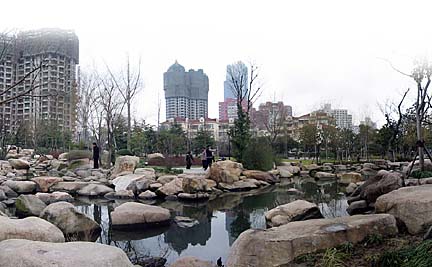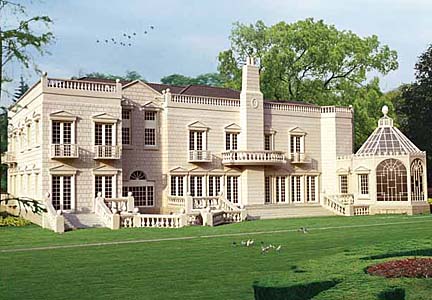
|
Isle firm helps
shape Shanghai’s
rapidly growing skyline
» Building China's future
» Englert stresses math, science studies
The Hawaii-based architectural firm AM Partners Inc. is contributing to the development of Shanghai and its soaring skyline.
Thirty percent of the company's work is in China, primarily in Shanghai, with some projects in Beijing and Guangzhou. There, the firm specializes in residential, retail and commercial projects.
Hong Kong native Charles Lau founded the company in 1985 so he could design a project in Xian, China. But he didn't pursue any more projects back then because bridging the differences between China and the United States, in terms of their legal and construction systems, was too difficult.
It wasn't until 1995, when some clients re-approached Lau to design a luxury housing project in Shanghai, that he began doing more work there.
When his Windsor Park Villas opened, the homes commanded the highest rental fees in Shanghai at $15,000 per month. Lau recently finished designing another gated community, called Le Chateau.
He's now working on five high-rise residential towers, known as Chateau Pinnacle, in Shanghai. The project is similar to the luxury condos sprouting up in Honolulu's Kakaako area. Lau is also designing a mega-project in Shanghai that includes a five-star hotel, an office tower, a luxury executive apartment complex and commercial retail space.

|
Lau thinks Shanghai is architecturally the most progressive community in the world. "For architects like myself, it's our last window of opportunity in my lifetime to design without being too concerned about the cost of fine workmanship." Because labor and material costs are still low in China, compared with the United States and other developed countries, Lau says architects can do very detailed and exquisite design work that would be prohibitively expensive elsewhere.
In Hawaii, Lau said, architects have to design much more efficiently because of the high cost of labor and material.
"Over in Shanghai we can be creative. It's an architect's dream place to practice. It's eye-opening to see the skyline being shaped by various architects and designers from around the world, and being a part of it is very challenging," reflected Lau, who graduated from the University of Hawaii, where he studied architecture. His firm mentors architecture students in the school's Practicum Program.
Lau notes that nowadays there's a new trend in China. Even with the fast-paced development, China is becoming more conscientious of preserving history, and some people are more appreciative of traditional design. It's an exciting time for Lau, who feels fortunate he's contributing to a significant moment in China's history.
is a frequent contributor to the Star-Bulletin. From 2000-2001 she was
the information specialist for the UH School of Architecture.

|
Home designs integrate
East and West
Some developers are adding Chinese
elements to their Western-themed projects
Special to the Star-Bulletin
For the past 5 years, Wimberly Allison Tong & Goo has been developing projects mainly in China's major cities and coastal areas. In 2004 the firm grossed more than $10 million in China projects alone. China has now become the second-largest market (after the United States) for the company, which specializes in hospitality, leisure and entertainment design.
These days 50 percent of the work coming out of WATG's Honolulu office is being done in China, according to Chao "Robert" Zheng, the company's director of development for the Asia-Pacific region and a graduate of the University of Hawaii School of Travel Industry and Management.
Most recently, the firm designed the Sandalwood Estates residential project in downtown Shanghai, which is near completion. The selling price is $12 million per home, a ton of money for each European-designed home. In all, there are 18 units, averaging 16,000 square feet per unit.
Since China opened its doors in 1978, China has had a thirst for mainly Western-influenced developments. But now some developers are trying to integrate Chinese historical elements and culture in designing their projects, according to Zheng.
"Before, they were totally against it," he said. "They used to say, 'Don't design anything Chinese at all in my project.'"
Zheng thinks the China market is changing. Developers realize there is a small but growing demand to provide some Chinese influences in their resort and residential projects.
"We always recommend to our clients to consider incorporating their culture and customs into the projects, which will help to promote their culture to the outside world and help them feel proud of their own culture," explained Zheng, who was born in China's Hunan province.
He believes more opportunities are opening up in China for outside investors, developers and architects.
"The timing and place is right because China is desperately looking for foreign expertise to help them develop the country," said Zheng.
is a frequent contributor to the Star-Bulletin. From 2000-2001 she was
the information specialist for the UH School of Architecture.
[News] [Business] [Features] [Sports] [Editorial] [Do It Electric!]
[Classified Ads] [Search] [Subscribe] [Info] [Letter to Editor]
[Feedback]
